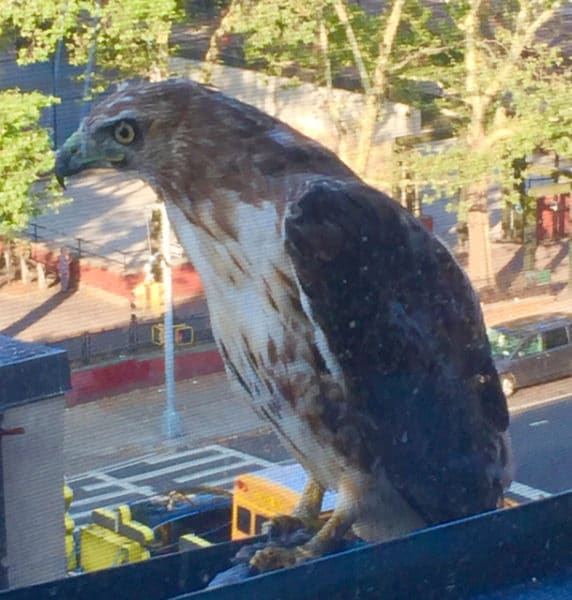Noted across from the handball courts at Grand Street by one of the Park’s many volunteer gardeners and a bird caregiver – Elizabeth Hardwick who wrote: “She is a baby Red Tailed Hawk.”
Yet another reason to use the dry ice method to remove rats in the park! Our bird caregiver has reported dead and dying birds who we believe have had contact with the lethal poisons currently used to kill rodents.
All agree. Not good for the environment. And not only during NYC’s ban during the hawks breeding season: March – August! See the excellent Patch article on the death of a Red Tailed Hawk from rodenticide in SDR Park in January.
A spokesman for NYC Audubon: “We advocate against the use of rodenticides in all places in the City, especially parks.”
More on Red Tails from NYC WildlifeNYC Website:
- As of 2016, there were at least 20 red-tailed hawk nests in Manhattan. In 2010 there were just eight (The National Audubon Society, 2016).
- Red-tailed hawks are top predators themselves and have no natural predators. Nonetheless, their eggs and nestlings are sometimes preyed on by great-horned owls, crows, raccoons, and red foxes.
- There are approximately 2.3 million breeding individuals worldwide. Nearly 75% of all red-tailed hawks spend portions of the year in the United States (Cornell Lab or Ornithology, 2015).
- Pale Male, the famous red-tailed hawk and Manhattan resident, is believed to have fathered nearly 30 chicks in his lifetime (The National Audubon Society, 2016).
- Red-tailed hawks fall under the protection of the Migratory Bird Treaty Act. The possession, transportation, or sale of hawks and their eggs is strictly prohibited.
- Migration does not occur often, but can be triggered by inadequate food resources. When it does occur, it takes place in the late fall and early spring in either an individual or group capacity.
Coexisting with Red-Tailed Hawks in NYC
- Do not feed red-tailed hawks. Red-tailed hawks are expert hunters and do not need help finding food. Feeding them can cause them to lose their natural hunting instincts.
- Observe and enjoy red-tailed hawks from a distance. Adult red-tailed hawks should always be admired from afar using binoculars or a scope. If you see a juvenile on the ground, there’s no need to approach it. The young bird is likely learning how to fly, and its parents may be nearby watching over it.
- Use snap traps rather than poison to control rodent populations. Eating rodents that have been poisoned can make red-tailed hawks ill.
- Put decals on windows to make them more visible to red-tailed hawks. Red-tailed hawks often crash into windows that reflect the sky or trees. Put pictures or decals on windows to prevent red-tailed hawks from crashing into them.
Sources:
Cornell Lab or Ornithology (2015). All About Birds. Retrieved from
https://www.allaboutbirds.org/guide/Red-tailed_Hawk/lifehistory
The National Audubon Society (2016). Fearless and Well-Fed, New York City’s Red-
Tailed Hawks Are Flourishing. Retrieved fromhttp://www.audubon.org/news/fearless-and-well-fed-new-york-citys-red-tailed-hawks-are-flourishing

